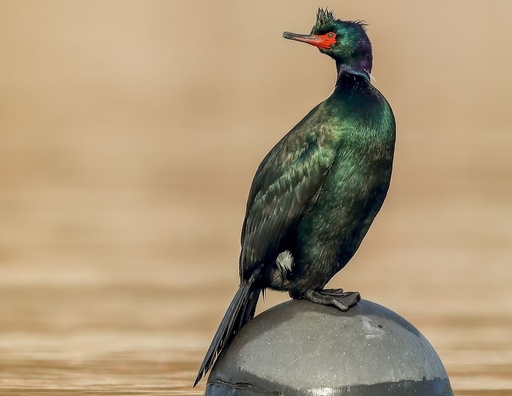Phoebastria immutabilis
IUCN
LCBasic Information
Scientific classification
- name:Phoebastria immutabilis
- Scientific Name:Phoebastria immutabilis,Laysan albatross
- Outline:Waterfowl
- Family:
Vital signs
- length:About 81 cm
- Weight:2.21-2.8kg
- lifetime:12 to 62 years
Feature
It is white from chin to rump, but dark on the upper wing and back, mainly white on the underwing, with dark edges, and a nearly black longitudinal covering
Distribution and Habitat
Origin: Canada, Japan, Marshall Islands, Mexico, Federated States of Micronesia, Northern Mariana Islands, Russian Federation, United States (Hawaii) and surrounding small islands and outlying islands.
Wandering: New Zealand, Norfolk Island.
Uncertain distribution: Taiwan, South Korea.
It is found mainly on small islands and nearby seas in the open ocean. During the non-breeding period, it is mainly active and inhabits the open sea and gulf areas, and does not live on land except during the breeding period. Flying all day long over the wide ocean, sometimes soaring high in the sky, sometimes flying close to the sea.
Appearance
The Laysan albatross is a medium-sized albatross, 81 cm long, with a wingspan of 195-215 cm, a weight of 2210-2800 grams, and a lifespan of 12 to 51 years (as of 2013, a Laysan albatross named Wisdom lived 62 years). It is a large bird with extremely long wing feathers. Males are slightly larger. It is white from chin to rump, but dark on the wings and back. The underwing is mainly white, with dark margins, and the coverts have nearly black longitudinal stripes. Dark eyes and eye circumference. Fly with your feet slightly behind your tail. Young birds resemble adults but have grayer beaks.
Iris dark brown, beak yellow, beak dark, feet pink gray.
Details
The Laysan albatross (Phoebastria immutabilis) is a medium-sized albatross with no subspecies.
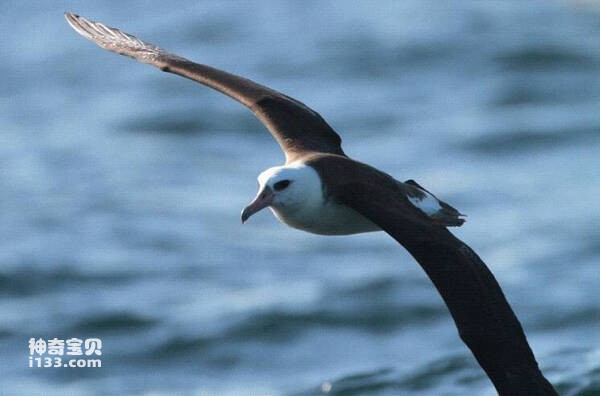
Laysan albatrosses are known for their effortless flight - they can glide for hours on boats with barely a beat of their wings. One of their adaptations to reduce the amount of energy used by their gliding muscles is a special tendon that holds the extended wings in place. Another is the astonishing length of the wings. Compared with other birds in the order petrel, the albatross has an unusually long forearm skeleton compared to the finger bone, with 25 to 34 secondary flying feathers on the wing, compared with only 10 to 12 in the petrel. As a result, Laysan albatross wings are extremely efficient wings, with a high aspect ratio (the ratio of wing length to front and back width) allowing them to glide forward rapidly with little chance of sinking. This adaptability to fast, long-distance flight allows Laysan albatrosses to take off from their island breeding bases and soar into the open ocean.
The Laysan albatross is known to be a scavenger, feeding on waste thrown from boats. Their diet ranges widely, but detailed analysis of the contents of their stomachs has revealed that fish, squid, and crustaceans constitute the most important food sources for the Laylays. They hunt these foods mainly at the surface, but occasionally burrow into the water like boobies, to depths of 6-12 meters. Laysan albatrosses sometimes feed at night, when a lot of Marine organic matter rises to the surface. Detailed information about the proportion of albatrosses that feed during the day versus at night can be obtained by persuading them to swallow a sensor. The sensors, located in the stomach, record the immediate drop in temperature that occurs when an albatross swallows a fish caught in the frigid waters of the Southern Ocean. The proportion of food components ingested varies from species to species, and this has a strong impact on the reproductive biology of albatrosses.
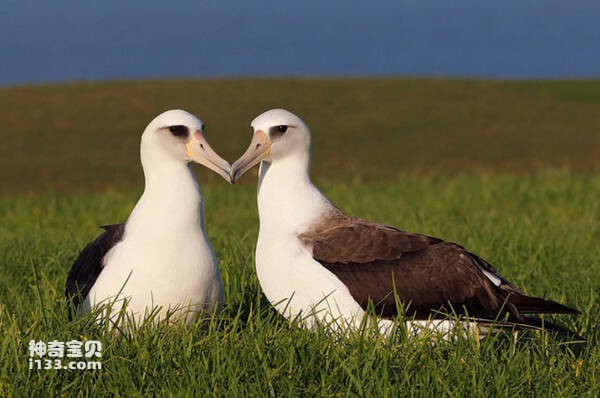
Laysan albatrosses are quite long-lived, living an average of 30 years. But they breed late. Although they are biologically capable of reproduction at 3-4 years of age, they do not actually begin to reproduce for several years, and some do not reproduce until they are 15 years old. After reaching sexual maturity at 8-9 years, Laysan albatrosses move from the sea to permanent residence, returning to land, where males come first to the colony at the beginning of the breeding season and then mate when females join in. When the Laysan albatross courts, it sings "cooing" incessantly and bows to its "sweetheart" in a very gentlemanly manner. They especially like to extend their beaks into the air in order to show their lovers their graceful curves. It takes 10 months, almost a year, to raise a chick. The first breeder is to engage in an elaborate courtship display, which establishes partners who live together for 40 years.
Most Laysan albatrosses nest in groups, sometimes tens of thousands of pairs together. The nest is a very large pile made of soil and plant material. The male and female build a shallow nest in the open ground surrounded by tall vegetation. The female lays only one egg. The brooding task is shared by both parties, and is usually rotated every few days. The incubation period is about 9 weeks. For hatchlings, the parent birds are mainly fed at first, and then mainly nursed. The birds are fed jointly by their parents, who alternately bring food back to the birds and begin flying over the sea for several days in turn to forage. During brooding, both parents take turns to go to distant feeding areas for food, as short as 1-3 days, as long as more than 5 days. On return, stomach oil and partially digested stomach contents are returned to feed the bird.

After 20 days of birth, the nursing period ends, and the adult birds only return to land periodically to feed the chicks. The chicks will often walk around 30 meters from the nest during the day, looking for shade, but as soon as the parent bird arrives with food, they rush back to the nest. The adults stay on shore long enough to identify the chicks, feeding them undigested Marine animal meat and the fat-rich oil produced by digesting their prey. Laysan albatrosses take 120 days to grow into full bloom. At the end of the breeding season in July, most birds head northwest toward Japan and then northeast toward the Aleutian Islands off the coast of Alaska. They then move south to Hawaii for the next breeding season.
After reaching maturity, young birds appear at the breeding grounds near the end of the breeding season, but only briefly; Over the next few years they will spend more and more time on shore in search of a future mate. When a couple is established, they usually live together until one of them dies. "Divorces" only occur after several breeding failures, and are costly because they do not reproduce for several years. In fact, for wandering Laysan albatrosses, a divorce can permanently reduce their reproductive success by 10 to 20 percent.
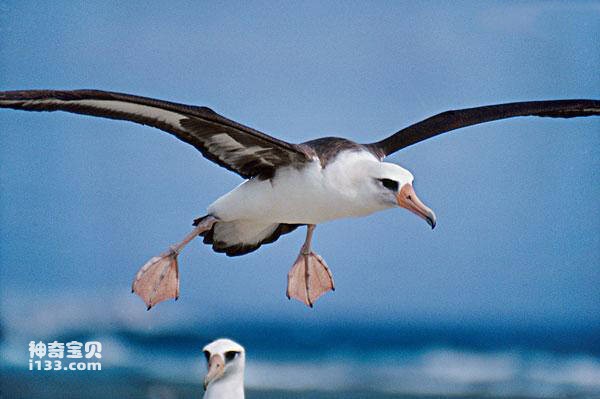
The breeding colonies of Laysan albatrosses have long been well protected because they are isolated islands with no natural predators. However, after being discovered by the sailors, they suffered great losses: eggs were seized and adult birds were killed. As feathers were used in the manufacture of human clothing and bedding, they were pillaged. The species survived because the immature birds were out of their breeding grounds, wandering the sea in relative safety, and later returned on their established course, thus "saving" the whole species. Since the resumption of breeding in 1954, short-tailed albatross populations on Japan's Minamitori Island have seen a slow recovery, with one of the main breeding groups now numbering about 200 pairs. The Laysan albatross was threatened by the use of Midway, an American air base in the north-central Pacific. The birds nest around military bases and airport runways, and many have been killed in collisions with antennas and aircraft.
The Laysan albatross faces more insidious dangers at sea. In addition to oil spills and chemical contamination, a more immediate threat comes from human fishing. Although gillnets are now banned on the high seas, the so-called "longline method" is widely used to catch bottom fish such as Chilean bass and mid-level fish such as tuna. A single longline for tuna is 100 kilometers long. When the longline is in place, the hooks will disperse from the bow of the fishing boat. It's a temptation the albatross finds hard to resist. They swallowed the bait, got hooked, were dragged into the water by a longline, and were eventually pulled out hours later by the fisherman, along with other prey. As many as 44,000 albatrosses are killed in this way each year, contributing to the decline of some species in the southern Ocean.
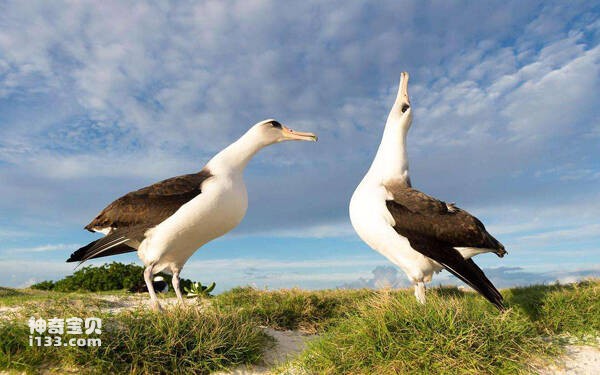
Some practical measures can effectively reduce this threat, such as laying rope at night. At the same time, international organizations are actively persuading countries and fishing fleets to adopt practices that are not harmful to Laysan albatrosses. However, as the world's fishing fleets further exploit the southern seas, a new threat is emerging: humans may compete directly with albatrosses and other animals for krill, squid and other Marine life resources, which will inevitably affect their survival.
Listed on the International Union for Conservation of Nature (IUCN) 2016 Red List of Threatened Species ver 3.1 - Near Threatened (NT).
Protect wild animals and eliminate wild meat.
Maintaining ecological balance is everyone's responsibility!




